Can it be Fixed with PDR? A Complete Guide to Paintless Dent Repair
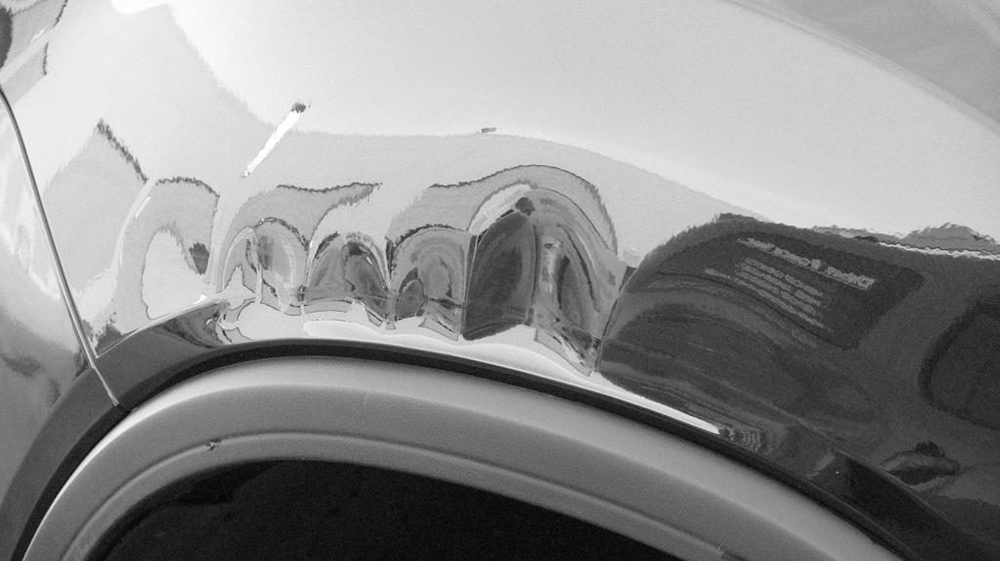
Can My Dent be Fixed with PDR?
If your vehicle has sustained a nasty dent, whether it’s a parking lot ding or an accident-related dent, there’s a good chance it can be repaired with PDR. Most minor dents can be repaired by the dent repair experts at Dented, so long as the paint is still intact and the dent isn’t too complex in nature. Since paintless dent repair can remove 80-90% of dents, it is the best way to get a dent out of your car.
If we can access the area behind the dent, we can often massage it out using Paintless Dent Repair. The best thing about PDR is that we do not need to add body filler, repaint, or disturb your vehicle’s factory paint during the repair process. Because of this, PDR is also far less time-consuming than the traditional dent repair process, which involves sanding the body panel, applying body filler, and repainting it.
If you want to keep your vehicle dent-free for a fraction of the cost and in less time, paintless dent repair is a great way to restore your vehicle’s body panels. Most Paintless dent repairs cost much less than repainting or traditional repairs and can be completed in less than a day!
We understand that many of you still have questions about the paintless dent repair process, so we have created an in-depth guide to answer them. After reading this, you will have a better understanding of the repair process and whether or not your vehicle can be repaired with PDR.
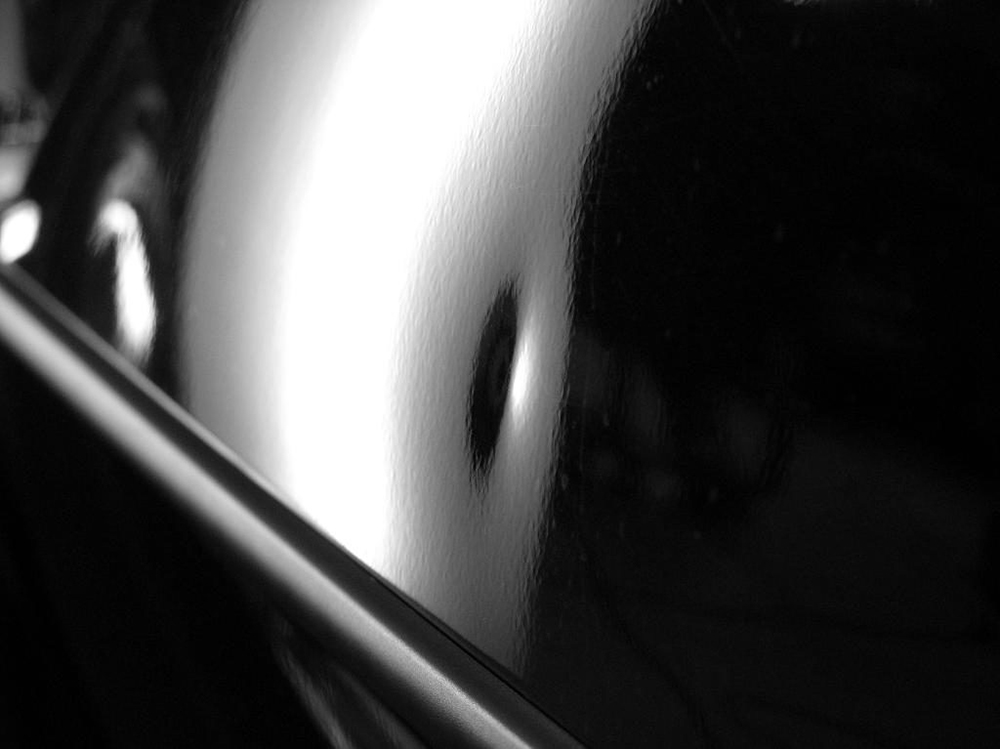
How to fix car dents of different shapes with PDR?
Every dent is unique in some way. No two vehicles have the same shape, and no two objects or other vehicles that could cause damage to your vehicle have exactly the same shape. As a result, we see a wide variety of dents in all shapes and sizes.
You may be wondering – “how does the shape of my dent affect its ability to be repaired with the paintless dent repair process?” – It’s a bit of a long-winded answer, but it plays a role in its repairability!
Dent Complexity
An important part of paintless dent repair and determining if the process can repair your dent is assessing the complexity of the dent itself. A more complex dent is more challenging to repair. There are a few different factors to consider:
Creasing in the Dent
If the dent is creased, it may not be repairable with PDR. Although there are many skilled PDR technicians worldwide, creases make it challenging to restore the body panel to its original shape. A good example of dent complexity and how creasing affects the dent repair process is squeezing a pop can or pop bottle.
Think of it this way. When you squeeze a pop can or pop bottle, it will leave a dent. If the dent you leave in it is round and smooth, you can usually hold the can or bottle with your hands and squeeze it back to its original shape.
However, if you crease the can or bottle when you squeeze it, no matter how hard you try to pop the crease out, a ridge will always exist. You can continue to fight with the dent and the crease as much as you’d like, but it will almost never return to its original shape.
The same theory applies to your vehicle. Although different materials are often used, and automotive paint has different properties and elasticity, a round dent is easier to pop out, and creasing will make it difficult.
Most PDR technicians have specialty tools, picks, hammers, and equipment that allow them to remove some dents with mild creasing, but these dents usually need to be repaired with the traditional dent repair process, as the paint will need to be disturbed and body filler applied. In some extreme cases, the panel may even need to be replaced.
The Depth of the Dent
Another important consideration is the depth of the dent in your vehicle. Shallower dents are often easier to repair than deeper dents. Given that more of the vehicle’s body panel will be affected by a deeper dent, it can limit repairability and the panel’s integrity. The deeper the dent, the less likely the panel will be to return to its original shape.
The elastic limit of your vehicle’s paint will also be a determining factor. Automotive paint can only flex so much before it cracks. The paint elasticity varies from one auto manufacturer to another. Some vehicles have different thicknesses and additives in the paint that allow their paint to be more flexibl,e whereas others are more brittle. A vehicle with more flexible paint can sustain a deeper, more complex dent without cracking, whereas a vehicle with more brittle paint and a harder clearcoat will crack sooner when damaged.
PDR technicians are trained to look for stress cracks and other signs that the damage may have exceeded the paint’s elastic limit before repairing your vehicle. If the paint shows signs of cracking, your panel will need to be repainted, and the traditional dent repair process will be required. It’ll be time to head to an auto body repair shop for that dent!
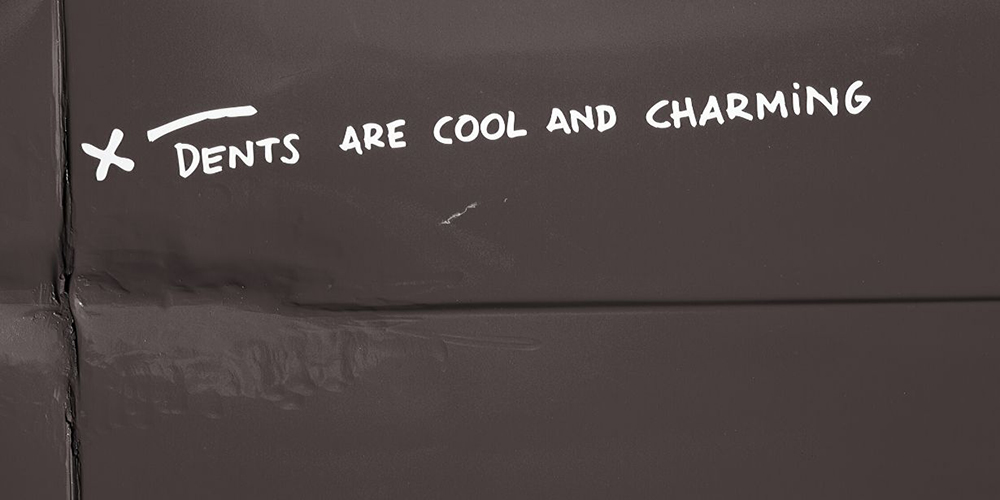
Common Causes of Small Dents that can be Removed from a Car with PDR
The wonderful thing about paintless dent repair is that it can fix a variety of small dents caused by different things. It’s by far the quickest and most cost-effective way to repair small dents. Some of you may be wondering what types of damage can be repaired with paintless dent repair and what the common causes of small dents are. Almost every vehicle owner will return to their vehicle after parking it somewhere and notice some damage at some point in their lives. We’ve created a helpful list of potential causes of a dent in your vehicle so you can determine what happened!
Collisions can be the cause of Small Dents
Collisions are often the cause of small dents. We all know that accidents happen and that vehicles sometimes bump into each other. If you see a small dent on your bumper, door, fender, or another body panel on your vehicle, it could have been caused by another vehicle bumping into it.
Look closely at your dent. If you can see another colour of paint in your dent, there is a good chance that another vehicle has bumped into yours. Although this may be alarming, the other vehicle’s paint will usually rub off, and so long as your paint has not cracked and the impact scratching is not too severe, these dents can be repaired with paintless dent repair.
Door Dings are a Common Cause of Small Dents
We’ve all done it before. Either you accidentally parked a bit too close to another vehicle, or they did at the grocery store. While you’re trying to put your groceries away inside the cab of your vehicle or get inside, you accidentally bump the door of another vehicle. In most cases, vehicles have side trim and other features to protect the body panels from damage. In some cases, vehicles lack them and end up with a nasty dent on the side.
Door dings have a pretty distinctive shape. Most doors have a round outer edge that contacts a body panel on your vehicle, which can cause your vehicle to swing. The result is a sort of egg- or crescent-shaped dent that sometimes has a ridge or mild crease on the inside.
In terms of the repairability of door dings, the same rules apply as for a small dent repair from a collision. There is often some impact from scratching on the surface from the other door coming into contact with your vehicle, and sometimes even a trace of other paint left behind. So long as the paint has not cracked, there isn’t any severe creasing in the dent, and the area behind the dent can be accessed, door dings can be repaired with paintless dent repair.
Hail Damage can be Repaired with Paintless Dent Repair
During the rainy season, PDR technicians are usually kept pretty busy with the many hail-damage repairs. Hail damage affects the horizontal body panels on a vehicle, typically. When hail falls from the sky, it often leaves tiny dents on the hood, roof, trunk, tops of the fenders, and quarter panels of your vehicle.
Bigger hailstones falling from the sky mean that there are likely bigger dents in your vehicle. In some cases, the sides of your vehicle can even be damaged by hail if there are heavy winds during a hailstorm. Strong blowing winds can cause the side of the vehicle facing the wind to be hail-damaged and also require hail damage repair.
The main thing to consider with hail damage is the size and quantity of the dents that your vehicle has sustained in a hail storm. If the hailstones are large enough, they can create dents that are too large or too complex to repair with paintless dent repair.
Because most hailstones are round in nature, they leave a dent in your vehicle that is similar to what would be caused by a golf ball. There is often no impact from scratching from hailstones because they are smooth, but PDR technicians will need to ensure that there is no stress cracking in your vehicle’s paint, as a deeper dent could exceed the elastic limit of your paint. As long as there is no cracking and the area behind the body panel can be accessed, a small hail-damage dent can usually be repaired. PDR is one of the best options available for hail damage repair.
Small Dents Caused by Sports Accidents
Another common cause of vehicle dents is sports accidents. We’ve all seen it happen in the movies before: a kid hits a baseball out of the park, someone’s aim is off with a golf shot, and a sports ball lands on a vehicle and damages it. In the spring and summer during sports season, this happens quite often.
Things like basketballs, baseballs, soccer balls, golf balls, and more can leave dents in your vehicle when they fly off course. Luckily, the dents caused by these sporting accidents are often minor, shallow, and round, and can be repaired through paintless dent repair.
When sporting balls come into contact with your vehicle, they often create a round dent with no impact or scratching. In extreme cases, golf balls can leave deeper dents, but this is unlikely. If your vehicle’s factory paint shows no signs of cracking in the area behind the dent accessible to a PDR technician, these small dents can often be removed, leaving your vehicle looking good as new!
Other Things That Cause Small Dents in Vehicles
Many other things can cause small dents in your vehicle. Things like falling objects, like an apple falling from a tree or something dropped from a roof can cause dents on your vehicle’s horizontal body panes. Even incidents as mundane as a shopping cart in a mall parking lot bumping into your vehicle or a child riding their bike into your vehicle can cause small dents.
Regardless of what caused the dent in your vehicle, so long as the dent is not too severe, the paint is intact, and the PDR technician can access the area behind the body panel, the paintless dent repair process can repair the small dents.

How does Paintless Dent Repair work for Body Panels?
Many people want to know which body panels can be fixed with paintless dent repair on a vehicle. The answer to this question isn’t completely straightforward. It depends on the material that the body panel has been made of, the shape of the panel, the severity of the dent, the location of the panel on the vehicle and how it affects access to behind the panel. We’ve gathered some information on the types of body panels that can be fixed with PDR.
Hoods can be fixed with Paintless Dent Repair
Generally, most alloy and sheet-metal hoods can be repaired using the PDR process. Since most hoods can be easily removed from the vehicle, and the liner can be removed from the hood, PDR technicians can easily access the area underneath the hood to pop out dents.
If your vehicle’s hood sustains a small dent from hail, a falling object, a sports ball, or another circumstance, it can generally be repaired with the PDR process. As long as the paint is still okay and the dent is not too complex. A PDR technician can repair the hood on your vehicle.
Some types of hoods, such as carbon fibre or fibreglass hoods, cannot be repaired with PDR. If you have one of these hoods on your vehicle, it is unlikely to be dented, but they will need to be replaced or repaired by an auto body shop.
Most Doors can be repaired with PDR
Like hoods, most alloy and sheet-metal doors on your vehicle can be repaired with the PDR process. Because most doors can either be easily removed from the vehicle or the door card, inner cover, or door skin can be removed, PDR technicians can easily access the area behind your doors to pop out dents and restore them to their original shape.
If your door has a small to medium-sized dent from a collision, a door ding, or another impact, it can generally be repaired with the PDR process. As long as the paint is not cracked, doesn’t have severe impact scratches, and the dent is not too complex, a PDR technician will be able to repair your door.
There are some instances where your door may not be repairable with PDR. Some vehicles have plastic door skins and other things where dents may not pop out, like metal or alloy will. If this is the case, your vehicle will need to go to an auto body shop.
Typically, Front Fenders can be repaired with Paintless Dent Repair
Because front fenders are generally easy to remove, the area behind dents in them can be accessed and repaired using the PDR process. Fenders usually bolt to a support or a part of your vehicle’s frame, making them easy to remove. Once removed, technicians can easily access the area behind them to pop out dents and restore them to their original shape.
If your fender has sustained a dent from a collision or something else coming into contact with it, if the paint is intact, it can probably be repaired with the PDR process. There are some instances where your fender may not be repairable with PDR. Some dents in the fenders along the body lines are too sharp or complex to remove, so the fender needs to be restored to its original shape. In cases like these, the fender will need to be replaced, and your vehicle will have to be repaired with the traditional auto body repair process.
PDR Can Normally repair Quarter Panels
Quarter panels have some of the same characteristics as front fenders, but they cannot normally be removed from your vehicle. Quarter panels are usually an integral part of the vehicle’s body, like the body pillars that attach to them. In most cases, the area behind the quarter panels can be accessed from inside your vehicle’s trunk or where your taillight attaches to your vehicle.
If your quarter panel has sustained a dent from a collision, a door ding, or another impact, it can generally be repaired with PDR so long as the paint is intact and the dent is not too complex. Some dents on the body lines at the quarter-panel end are too sharp or complex to remove, and the fender needs to be restored to its original shape. In cases like these, body filler will need to be applied to the panel, and your vehicle will have to be repaired with the traditional auto body repair process.
PDR Can Normally repair the Vehicle’s Roof
The roof of a vehicle is a large, horizontal surface that is often prone to dents from things falling on it, like hail, baseballs, and even fruit! Luckily, most roof dents are completely repairable with the PDR process.
As long as the headliner in your vehicle can be removed, it is fairly easy for a PDR technician to access the area behind your dents and remove them from your vehicle’s roof. Hail damage and other roof dents from round objects falling on them can generally be removed, as they do not damage your paint or severely deform the panel. In some cases, where a tree branch, a rock, or a heavy object has fallen on your roof, the dent may be too severe to be repaired with PDR. In these extreme cases, your vehicle will need body filler to be applied or even a new roof.

How does your Paint Affect the Process of Getting the Dent out of the Car?
Although it may seem like your paint has nothing to do with removing a dent from a metal or aluminum body panel, it actually has a lot to do with it and what the limits of the PDR process are!
As we previously mentioned, automotive paint has an elastic limit of how much it can stretch before cracking occurs. Some paints are more flexible than others and can sustain a larger, more severe dent before the paint is damaged or disturbed. If the paint has cracked or it has been scratched down to the metal, it is unlikely that the paintless dent repair process will repair your dent, and your vehicle’s body panel will need to be repainted.
The cool thing about modern automotive paint is that it provides more than just aesthetic value. It does a lot more than make your vehicle look pretty! It acts as a protective layer and has many desirable properties.
Most water-based acrylic polyurethane enamel paints have excellent elasticity and remain very environmentally friendly. Because of their great elasticity and resilience, impacts and dents that would normally cause your paint’s elastic limit to be exceeded and crack or become damaged are now completely repairable by the PDR process.
Some older automotive paints lack the elasticity and resilience of modern automotive paints. Some exceptions to this rule do exist, though. Some modern vehicles use more brittle paints and clear coats, which can make paint less elastic than water-based acrylic polyurethane enamel paints. We’ve all seen old vehicles in junkyards and parking lots from the seventies and eighties, where a minor dent has caused the paint to crack and begin to chip off. In cases like this, the panel needs to be repainted.

Body Panel Materials that can be Repaired with PDR
Generally, most metal and alloy body panels can be repaired using paintless dent repair. If your vehicle is made of sheet metal, aluminum, or an alloy, so long as the panel isn’t too severely damaged, it can be repaired with the PDR process. This is because these types of panels can be shaped with manual tools, are malleable, and have a metal memory, as discussed above. Most vehicle body panels can be repaired using paintless dent repair, but some cannot.
Materials that PDR cannot repair
Some body panels are made of different materials for good reason, but they cannot be repaired with paintless dent repair. Things like plastic bumpers, fibreglass fenders, carbon fibre hoods, and composites cannot be repaired using paintless dent repair.
This is because most of these materials are unlikely to dent to begin with. Although plastic bumpers and doors sometimes sustain dents that can be popped out easily, these panels cannot be repaired with PDR, as they lack the metal memory of other panels. When damaged, plastic panels are usually just discarded and replaced. Things like bumpers, trim, and other plastic parts of your vehicle will need to be ordered from a dealership or auto body shop.
When it comes to more brittle materials like fibreglass or carbon fibre, the materials are more likely to crack or split when damaged and do not dent. If this is the case, they will need to be repaired with filler or professionally by another specialist.
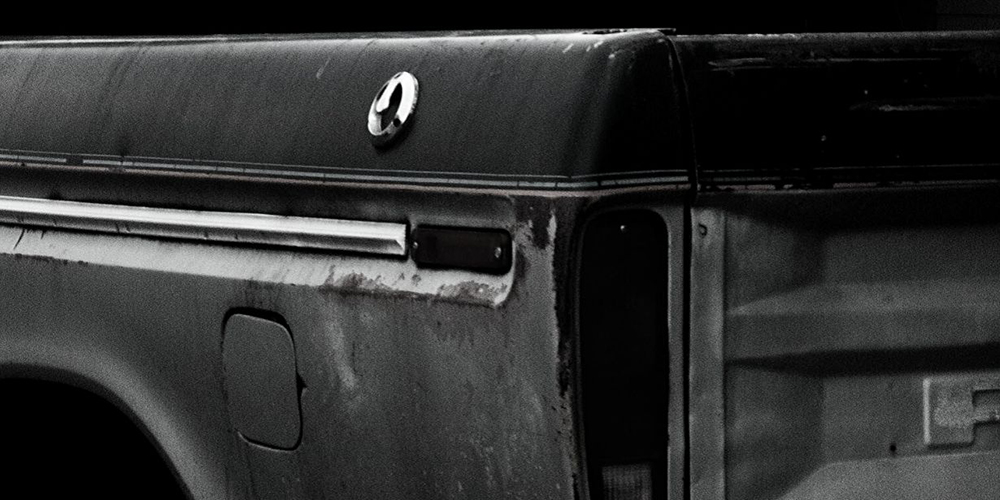
The Types of Vehicles that can be Dent Repaired with PDR
Almost any vehicle can be repaired with PDR. As long as the vehicle is constructed from one of the repairable materials listed above, it can be repaired using paintless dent repair. The PDR technicians at Dented have repaired it all! When it comes to cars, we have worked on coupes, sedans, wagons, high end sports cars, and more. We love pulling dents out of beautiful cars and restoring them to their original condition.
We have worked on many different types of larger passenger vehicles to remove dents as well. We have used paintless dent repair to fix dents in trucks, SUVs, Jeeps, Crossovers, Vans, Mini Vans, Panel Vans, and more.
Whether your vehicle has unibody construction or body-on-frame, we can remove dents and make it look as good as the day you first drove it home. Different vehicles come with different complexities, but they can all almost certainly be repaired with paintless dent repair ,so long as the damage is not too severe.
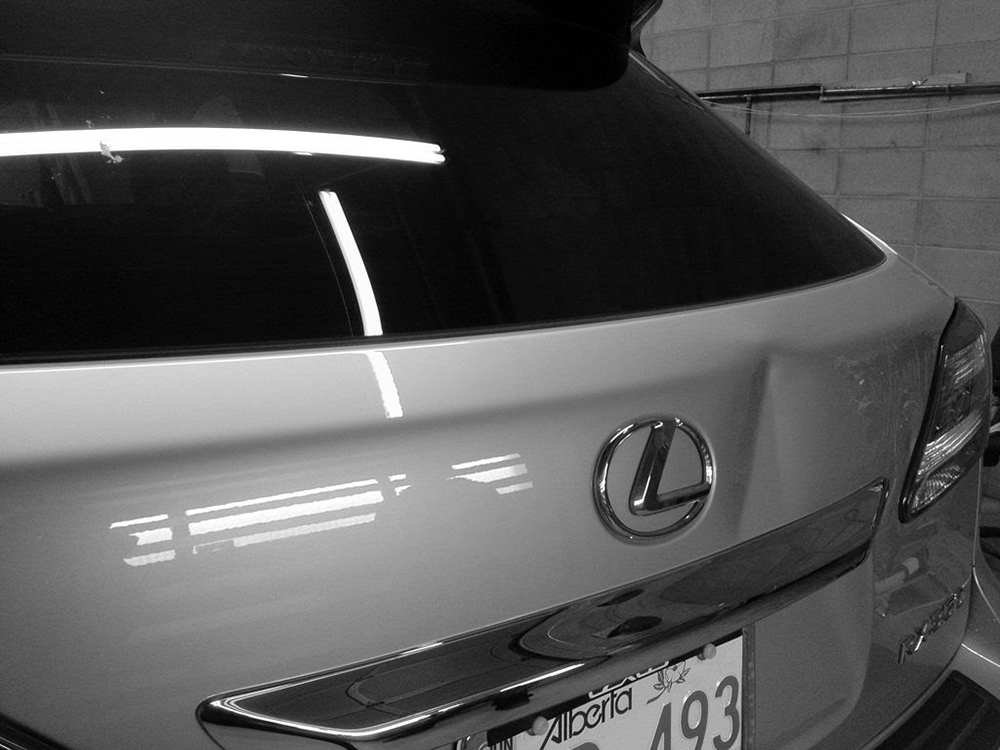
How does Metal Memory Affect the Paintless Dent Repair Process?
One of the things that the paintless dent repair process relies on is “Metal Memory”. This means the metal tends to return to its original shape. Normally, this can be attained with PDR as long as the dent hasn’t exceeded one of the limits we have mentioned above.
The problem with larger dents is that sometimes the metal can become stretched. This is what happens typically when your paint starts to crack. In these cases, it will no longer want to return to its original shape as it has been given a new memory.
When a dent has a sharp ridge, creasing, or anything that could cause the metal to twist or tear, the metal has almost certainly been stretched. This is why these cases make it extremely difficult to repair with the PDR process. Panels like this often require body filler or replacement to make them appear as if they still retain their original shape.
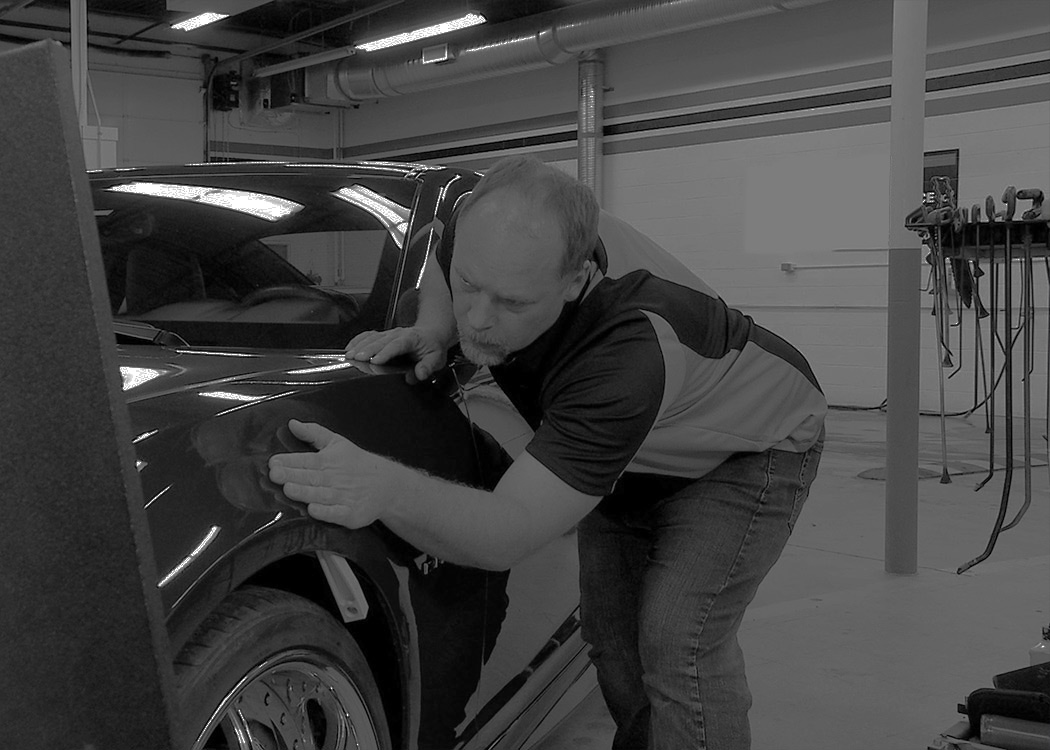
The Paintless Dent Repair Assessment Process
Many of our customers wonder how the paintless dent repair damage assessment process works. It’s really quite simple! Damage assessment needs to occur before we begin working on a customer’s vehicle to ensure we aren’t trying to repair a dent that cannot be repaired due to its severity or another roadblock.
The first step in the assessment process is to examine the dent and determine its severity. Our estimators will look for many of the signs we mentioned above that indicate your dent may not be repairable. They ensure the metal is not stretched, the paint’s elastic limit has not been exceeded, that there are no extreme ridges or creases in the dent, and that the impact scratching can be polished out. If the dent falls within these parameters, the estimator proceeds to the second step.
The second step in the paintless dent repair process involves accessing the area behind the dent. Given that your dent could be anywhere on your vehicle, it may be in a location where a PDR technician cannot access the area behind the dent, which will impede repair. If it is impossible to access the area behind the dent for whatever reason, the dent cannot be repaired with PDR.
The third step is to estimate the cost of dent repair for the panel on your vehicle. Estimators look at the factors above and the quantity of dents, then perform a dent repair cost analysis and estimate. In some cases, if there are many dents on a panel or the cost of PDR repair exceeds the cost of replacing the panel, we will suggest that the customer take that route. The estimator will also take into account damaged trim pieces and provide a quote for replacing parts like these.
After this has been completed, a quote is created and reviewed with the customer or the insurance company. If the quote is approved, the repair is scheduled, and the PDR technicians will repair the vehicle.
Although there is an in-depth assessment process, 80-90% of vehicle dents can be repaired using PDR. We complete the assessment process to ensure we are working in the customer’s best interests and that the repair can be completed without complications. We want to ensure that your car looks as good as the day it rolled off the lot after your dents have been repaired with paintless dent repair.
The Average Paintless Dent Repair Cost
The cost of repairing your dent depends on the factors listed in the assessment process above. A more complex dent will take longer to repair and cost more than a simple dent repair. A dent that is more difficult to repair, because the area behind the dent cannot be easily accessed, will take the technician longer to repair and cost more.
Another thing to consider is the number of dents on your vehicle. A roof with hail damage and 30 dents will also be more expensive to repair than a single door ding. Regardless, it is difficult to ballpark the cost to repair your dent. No two dents are alike, so it is hard to compare!
Regardless of the cost, paintless dent repair is always cheaper than traditional dent repair and better for the environment, too. Because we don’t use body fillers, repaint, or harmful chemicals in the paintless dent repair process, we don’t harm the environment, and we save you money. Although our trained technicians have a comparable labour rate to an auto body shop, we can often repair dents quickly and save on material costs compared to the traditional dent repair process. Paintless dent repair is the most cost-effective and efficient way to repair dents on your vehicle.
For all of your Paintless Dent Repair Needs, Visit Dented
We hope you found this comprehensive guide on paintless dent repair helpful and that it answered many of your PDR-related questions. We want to ensure that you’re well educated about vehicle repair so you understand how PDR can fix your vehicle without breaking your wallet. It really is one of the best ways to get a dent out of your car.
At Dented, we go the extra mile to ensure that having your dents repaired is as quick and painless as possible. We treat each and every customer’s vehicle like our own and ensure the best workmanship and quality with every repair we complete. That is the Dented advantage, and it is how we deliver quality that our competitors cannot match. If you want your vehicle repaired by true professionals so it looks as good as the day it drove off the dealership parking lot, pay a visit to Dented today for a quote.
Why Dented is Regina’s Choice for Paintless Dent Repair
"*" indicates required fields





